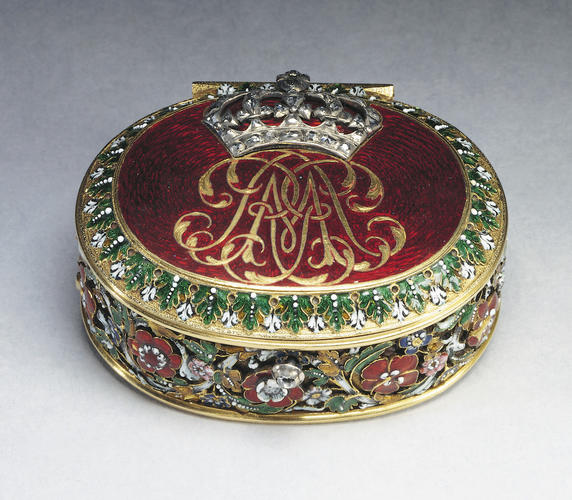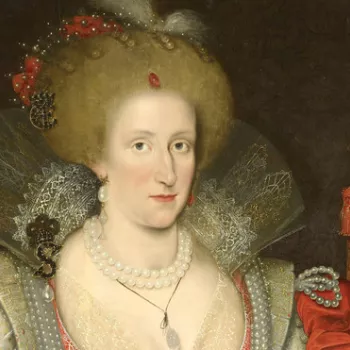Queen Mary II's patch box c.1694
Enamel, gold, diamonds | 2.3 x 5.2 x 4.5 cm (whole object) | RCIN 19133
-
The maker of this remarkable enamelled gold box, which bears the crowned monogram of Queen Mary II, is not recorded. However, the sophisticated use of enamels and engraving indicates continental craftsmanship, probably the work of a foreign jeweller in London. Queen Mary's accounts indicate that she had a weakness for jewellery and bijouterie of all kinds. The maker of this box was almost certainly the same as that of the agate and gold box discovered in Holland in the 1960s. The latter may be identifiable with the 'Gold pach box with an Agatt Stone Cover' purchased by the Queen on 10 May 1694 for £10 from the jeweller James Schuelt, whose name suggests a Germanic origin.
Patch boxes were used to contain face patches, worn from the early seventeenth century to disguise blemishes, particularly smallpox scars. By the time of the Restoration, patches had become highly fashionable accessories; as many as seven or eight were worn at a time and elaborately decorated boxes such as this one, with sprung and mirror-lined lids, were much in vogue. The fashion attracted criticism from moralists of the day, who considered face patches a sign of grotesque vanity. Despite the Bishop of Gloucester boasting that Queen Mary 'did not entertain such childish vanities as spotted faces', her accounts show that during the last year of her life she was regularly buying 'paper for patches' costing 1s. a sheet from her milliner. Ironically the Queen died of smallpox, at the tragically young age of 32 in December 1694. It is possible that the box was then presented to Anthony, eleventh Earl of Kent, one of six pall-bearers at her funeral in March 1694/5. Alternatively it may have been given to Hans Willem Bentinck, first Earl of Portland, a close confidant of William III; Portland's daughter, Elizabeth Ariana, was the grandmother of John, seventh Earl of Bridgewater.
Publications have suggested that the surface of the box may have been engine turned but recent investigations have ascertained that the red enamel is applied over a manually engraved gold surface.
Catalogue entry from Royal Treasures, A Golden Jubilee Celebration, London 2002Provenance
Supplied to Queen Mary II c.1694; possibly presented to Anthony, eleventh Earl of Kent, 1694/5; thence descent to John, seventh Earl of Bridgewater; inherited in 1849 (with the Egerton estates) by John, second Earl Brownlow; from whom by descent to Peregrine Adelbert Cust, sixth Lord Brownlow; by whom sold Christie's, London, 29 May 1963 (21); purchased by Queen Elizabeth II (£8,500)
-
Medium and techniques
Enamel, gold, diamonds
Measurements
2.3 x 5.2 x 4.5 cm (whole object)
Category
Object type(s)









